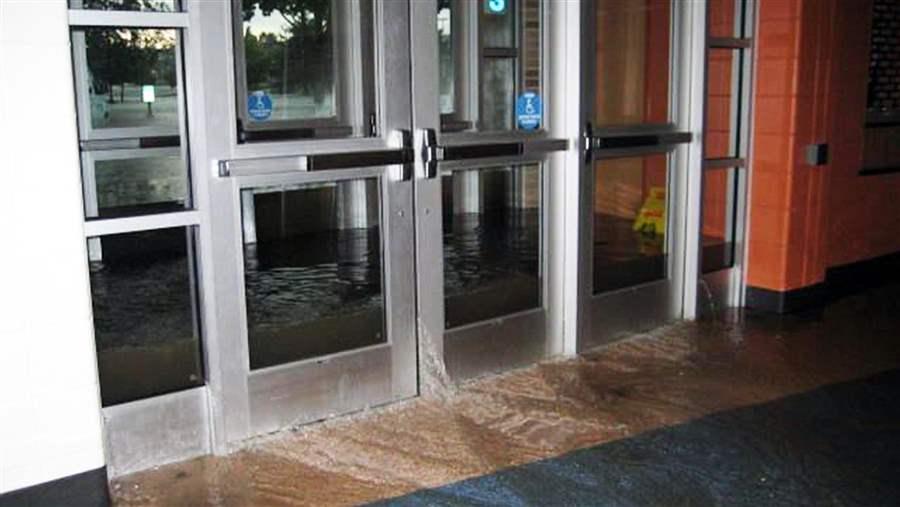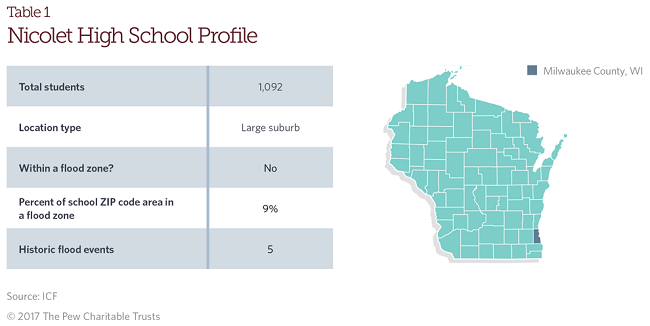Flooding Spurs Renovations at Wisconsin School
Stormwater management project increases flood resilience

Nicolet High School outside Milwaukee flooded during rainstorms in July 2010, so the school spent $1.2 million on modifications.
© Brian ReielsOverview
On July 22, 2010, thunderstorms dumped 8 inches of rain on the Milwaukee area, leading to widespread flooding. Highways and airports were closed, thousands of homes were evacuated, and sewer systems were overwhelmed.1 Nicolet High School, which draws more than 1,000 students from suburban Glendale and surrounding towns, was badly damaged.
A sediment barrier that had been built near the school washed out, and mud, silt, and water inundated the parking lot, storm drains, and the building itself.2 High humidity damaged paint, ceiling tiles, and electronics.3 Summer programs had to be canceled or moved, and the start of the school year was delayed.4 But this was nothing new for the school: It had flooded at least four times before.5
Faced with escalating insurance costs and wanting to avoid further damage and disruption, the school spent $1.2 million on modifications to better manage stormwater runoff. If a major storm strikes again, floodwaters will be diverted away from the school, and administrators hope its doors will remain open.
Water came down from the highway and knocked in the doors and flooded the school. Everything below grade was filled to the ceiling with water.John “J” Murphy, senior vice president of operations at Paul Davis National, an emergency response firm
Diverse sources of funding for disaster response
Nicolet paid for the $14 million in damage through a combination of insurance, state, and federal funds. Property insurance through the Wisconsin Local Government Property Insurance Fund, which provides insurance to local governments, covered $12.9 million of the cost. The Federal Emergency Management Agency and Wisconsin Division of Emergency Management covered 75 percent and 12.5 percent, respectively, of the remaining costs. Reserves from the school district fund balance paid the rest.6
The damage at Nicolet High School was the biggest loss the state’s insurance fund had incurred.7 Because of the large payout, the fund established a $1.5 million limit for coverage of stormwater runoff. This new cap led Nicolet to search for more comprehensive coverage and to switch companies, at a cost of over $100,000 a year, in July 2011.8 Still able to get only half the amount it needed, the school board invested in flood preparedness improvements to bridge the gap.9 The investment in a better stormwater management system dropped the insurance premium from $100,000 to $60,000.
Making the most of investment by looking ahead
The 2010 storm was a turning point. Rather than sharing storm sewers with the local municipality, as it had done, the school now has a higher-capacity stand-alone stormwater system that diverts water directly to the Milwaukee River.10 It also redesigned parking lots and driveways to collect and temporarily hold runoff during heavier rains and installed spillways that divert water away from buildings.11 A dry “pond” near the main entrance has a capacity of 7 inches of water from Nicolet’s parking lots and driveway areas.12
Since the project’s completion in 2013, several storms have hit Nicolet. But the modifications have paid off: Floodwaters have not inundated the school.13 By investing in projects to alleviate and redirect the rainfall, school administrators have helped to prevent new damage, delays, and disruptions for students.
Flood-resistant building design protects investments
Every time we had a rainfall event between July 2010 and 2013, we worried about another flood. But after completing our flood mitigation project, we no longer worry about the school.Brian Reiels, director of facility services at Nicolet High School
When flooding damages critical infrastructure, such as schools, the effects on residents and businesses—and the costs of repair—are substantial. In recent decades, the country has underinvested in infrastructure, and many communities are finding that roads, bridges, and buildings were simply not built to withstand the impacts of changing weather patterns, especially in areas that are struck repeatedly. Smart investments like those made by Nicolet will ensure that infrastructure meets future needs and won’t need to be rebuilt down the line.
Endnotes
- National Weather Service, “Flash Flooding/Heavy Rain Event & Tornado Outbreak: July 22, 2010,” https://www.weather.gov/mkx/072210_flashflooding-tornadoes; National Oceanic and Atmospheric Administration, “United States Flood Loss Report—Water Year 2010,” http://www.nws.noaa.gov/hic/summaries/WY2010.pdf.
- John “J” Murphy, senior vice president of operations, Paul Davis National, discussion with Amanda Vargo and Hannah Wagner of ICF, Dec. 7, 2016.
- Ibid.; Paul Davis National, “Paul Davis National Provides Emergency Services for Nicolet Union High School District,” news release, Sept. 21, 2010, http://www.pdnational.com/Library/PressReleases/NicoletUnionHighSchool_9.21.10.pdf.
- Brian Reiels, director of facility services and director of safety and security at Nicolet High School, discussion with Amanda Vargo of ICF, Dec. 8, 2016; City of Glendale, Wisconsin, “Economic Profile: 2015,” http://www.glendale-wi.org/DocumentCenter/View/422.
- Reiels, pers. comm.
- Ibid.; Malcolm Stone, “High School Water Damage Puts Crews to the Test,” Restoration & Remediation, Feb. 2, 2011, http://www.randrmagonline.com/articles/83702-high-school-water-damage-puts-crews-to-the-test.
- Nicolet High School, “Nicolet High School Annual Report 2013,” http://www.nicolet.us/cms_files/resources/2013_annual_report.pdf.
- Ashley Sears, “Nicolet H.S. Spends $1.2 Million to Prevent Future Flooding,” Fox News 6, Aug. 1, 2013, http://fox6now.com/2013/08/01/nicolet-h-s-spends-1-2-million-to-prevent-future-flooding; Nicolet High School, “Nicolet High School Annual Report 2013.”
- Reiels, pers. comm.
- Sears, “Nicolet H.S. Spends $1.2 Million”; Jason Newton, “Nicolet Ushers In Waves of Students, Not Flood Waters,” WISN-TV, Sept. 3, 2013, http://www.wisn.com/article/nicolet-high-ushers-in-waves-of-students-not-flood-waters-1/6317281; WISN-TV, “Nicolet High School Takes Steps to Prevent Future Flooding,” July 22, 2013, http://www.wisn.com/article/nicolet-high-school-takes-steps-to-prevent-future-flooding-1/6316576.
- Sears, “Nicolet H.S. Spends $1.2 Million”; Nicolet High School, “Nicolet High School Annual Report 2013”; Newton, “Nicolet Ushers In Waves of Students.”
- Nicolet High School, “Nicolet High School Annual Report 2013”; Newton, “Nicolet Ushers In Waves of Students.”
- Murphy, pers. comm.








